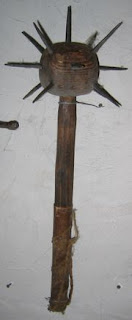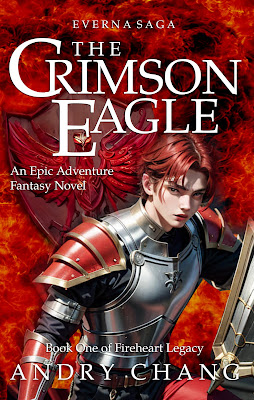Morning Star
 Morning star (weapon)
Morning star (weapon)From Wikipedia, the free encyclopedia
Jump to: navigation, search
Morning star at the torture museum in Freiburg im Breisgau.
The terms morning star, goedendag and holy water sprinkler are used to describe medieval club-like weapons which included one or more spikes. Each used, to varying degrees, a combination of blunt-force and puncture attack to kill or wound the enemy.
Contents[hide]
1 Morning Star
2 Goedendag
3 Holy Water Sprinkler
4 References
//
[edit] Morning Star
The morning star was a medieval weapon in the form of a spiked club resembling a mace, usually with a long spike extending straight from the top in addition to a number of smaller spikes around the circumference of the head. It was used by both infantry and cavalry, and the horseman's weapon typically had a shorter shaft. The mace, a traditional knightly weapon, developed somewhat independently, becoming all metal with heads of various forms, while the morning star retained its characteristic spikes, with a shaft generally made of wood and often found in longer two-handed forms measuring up to six feet or more, popular among footmen. The morning star first came into widespread use around the beginning of the fourteenth century, and the term is often mistakenly applied to the military flail ("fléau d'armes" in French and "kriegsflegel" in German) which consists of a wooden haft joined by a length of chain to one or more iron balls or an iron shod wooden bar, in either case with or without spikes (heavy sword pommels have also been used as weights).
Although it is often assumed that the morning star was a crude peasant weapon, that is not entirely correct. There were three types in existence, all differing in quality of workmanship. The first was the well crafted military type used by professional soldiers, made in series by expert weaponsmiths for stocking in town arsenals. The second and much simpler type would have been hand cut by peasant militiamen, rather than turned on a lathe, from wood they had gathered themselves (for which reason forests were often known as "arsenals of God") and fitted with nails and spikes by the local blacksmith. The shaft and head were usually of one piece but sometimes reinforced at the top with an iron band. The third type was decorative in nature, usually short hafted and made of metal (one sixteenth century example being of steel and damascened with inlaid gold and silver, in the Wallace Collection of London).
Two impressive examples of the military type are housed in the museums of Vienna, both from the sixteenth century. The first measures 2.35 m (7' 9") in length including the top spike which is 54 cm (21"). The head is a separate wooden cylinder slipped over the top of the shaft and reinforced with steel bands, with five metal spikes in symmetrical arrangement. The second example has an all steel head of complex craftsmanship with four V-shaped spikes mounted on a long shaft that measures slightly less than two meters in length. A twisted and braided steel bar joins the socket to the base of the top spike. There are also 183 surviving specimens in Graz, made in series and delivered to the arsenal in 1685. They are comparable in length to the previous examples and have three rows of spikes around the head. The wooden shafts of most morning stars of the military type are reinforced with metal langets extending down from the head. Still others can be found in the Swiss arsenals of Lucerne and Zurich.
These types of morning stars are also depicted in medieval art. For instance, one is shown being carried by an armored knight or soldier in the Caesar Tapestries in the Historical Museum of Bern, depicting Julius Caesar's battle against the Germanic leader Ariovistus. These tapestries were woven in Tournai between 1465 and 1470, and taken as plunder from Charles the Bold after one of his defeats during the Burgundian Wars against the Swiss. In the poem Le Chevalier Délibéré written by Olivier de la Marche and first published in 1486, there is an anonymous woodcut depicting a knight carrying a rather simple morning star with spikes mounted in an asymmetrical pattern as well as a flail equipped with a single spiked ball, known in German as a "kettenmorgenstern" which, despite its name, is a type of military flail.
[edit] Goedendag
Image:Goedendag.jpg
Most probable reconstruction drawing of a goedendag. Total length about 1 meter 35.
The Goedendag or Plancon was a Flemish weapon which is often described in modern sources as similar to the morning star, it was a pole arm that combined a spear with a mace. The name itself is thought to be sarcastic, as Goedendag is Dutch for "Good Day". It was used to great effect by the guildsmen of Flanders against the French during the Battle of the Golden Spurs in 1302. It was an infantry weapon in the form of a thick wooden shaft between 4 and 6 feet in length, slightly fluted toward the top, from which emerged a stout iron spike. It is depicted in the carvings on the Courtrai Chest (located within New College, Oxford, England) being used along with the long spear of the Flemish, the geldon, against the French knights. As Kelly DeVries states in Medieval Military Technology, the spear part was used to pull the French knights from their horses and then the mace part was used to crush skulls and bones. It saw limited service, with the Flemish themselves abandoning the weapon at the beginning of the fifteenth century.
Flemish troops at the Battle of the Golden Spurs. In the center are men wielding the goedendag, also known as the plancon. Detail from the Courtrai Chest.
[edit] Holy Water Sprinkler
The holy water sprinkler (from its resemblance to the aspergillum used in the Catholic Mass), or goupillon in French, was a morning star popular with the English army from the sixteenth century and made in series by professional smiths. One such weapon can be found in the Royal Armouries and has an all steel head with six flanges forming three spikes each, reminiscent of a mace but with a short thick spike of square cross section extending from the top. The wooden shaft is reinforced with four langets and the overall length of the weapon is 6' 2".
The term can also be used to describe a type of military flail. Rather than a steel ball on the end of a chain, however, it features a short iron bar covered in sharp spines. It was (according to popular legend) the favored weapon of King John of Bohemia, who was blind, and used to simply lay about himself on all sides, as one does not need to see one's opponent. It is easy enough to just "flail" until hitting something.
[edit] References
Dictionary of Medieval Knighthood and Chivalry by Bradford Broughton (NY, Greenwood Press, 1986, ISBN 0-313-24552-5)
Hafted Weapons in Medieval and Renaissance Europe: The Evolution of European Staff Weapons Between 1200 and 1650 by John Waldman ( Brill, 2005, ISBN 90-04-14409-9)
Medieval Military Technology by Kelly DeVries (Broadview Press, 1998, 0-921149-74-3)
Retrieved from "http://en.wikipedia.org/wiki/Morning_star_(weapon)"
Categories: Clubs Medieval weapons


Comments
Post a Comment